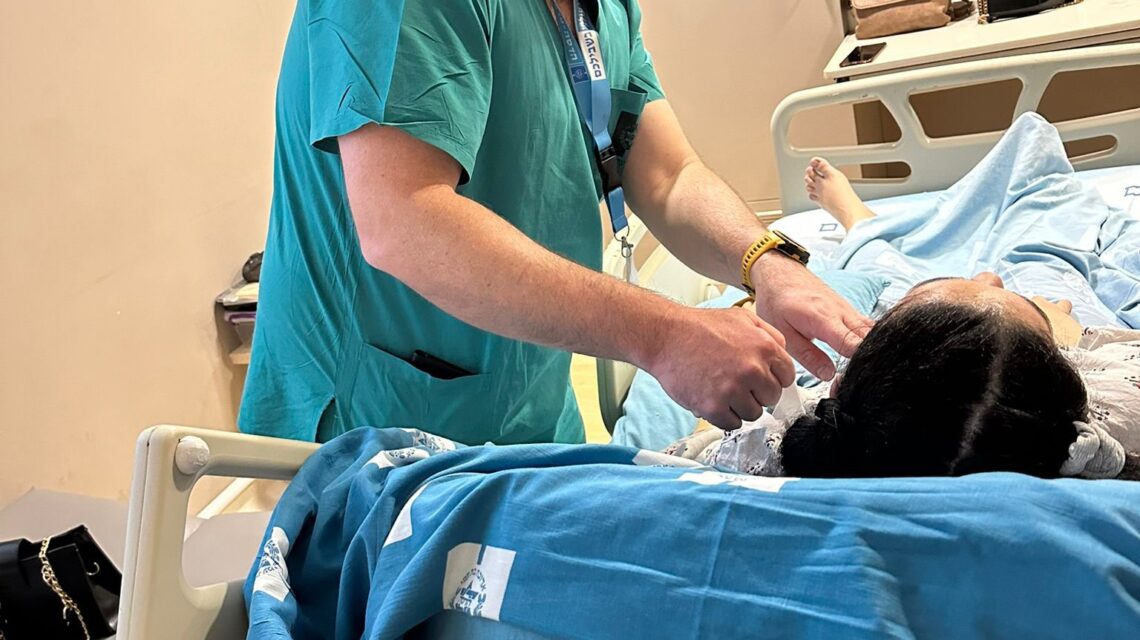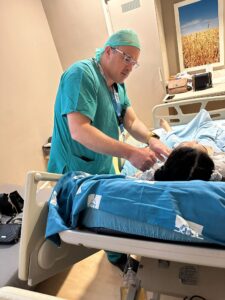
A 19-year-old was driving a go-kart when the edge of her headscarf got tangled in the wheels of the vehicle, pulling her head violently and severely injuring her cervical vertebrae.
Professor Josh Schroeder, head of the Spine Surgery Unit at Hadassah: “We rushed with the young woman from the MRI scan to the operating room, and just before we entered, we promised her worried parents that we would do everything to ensure their daughter could move her limbs and wouldn’t remain paralyzed.”
A karting outing of a 19-year-old girl from Jerusalem almost ended in a disaster. Only an emergency orthopedic surgery performed at Hadassah Ein Kerem saved her from permanent paralysis in both her legs. When A. went out with her family, she did not imagine that the day planned at the go-kart track would end with an urgent evacuation by ambulance, with her life in immediate danger.
“We heard about karting and wanted to enjoy it together as a family,” her mother recalls. “We all went to the complex, and when it was our turn, we received instructions on operating the vehicles and wearing the helmet. We immediately did everything they asked of us and were launched onto the track. The kids enjoyed it. A.’s 15-year-old brother also went on the track, and I filmed them having fun. Suddenly, I noticed something was wrong,” she recounts emotionally. “The track was further from where her father and I stood, but I saw my daughter trying to free herself from the vehicle and crashing at a high speed into the wall.”
The 19-year-old recounts: “When they told me to wear a helmet, no one mentioned that the scarf covering my head could interfere in any way. So, I closed the helmet properly and started driving, even accelerating. It suddenly happened in the middle of the track – the long edges of my scarf got caught in the wheels and then wrapped around my neck. As the ride progressed at the speed I was going, the scarf wrapped tighter, cut my throat, and caused a sudden, violent pull that immediately injured the vertebrae in my neck. From that moment, I was paralyzed.
I couldn’t feel anything in my legs, I was terrified, and I couldn’t stop or even slow down and crashed the small car into the wall.”
A.’s condition was severe. She had bleeding cuts from the fabric wrapped around her neck and couldn’t move her lower limbs for a prolonged period. She remained conscious but was in a state of shock. The frightened family and the karting staff immediately realized the severity of the injury and called an ambulance.
“I insisted the ambulance take her to Hadassah Ein Kerem,” her mother says. “I knew only there they could treat such a serious injury and help her.” The ambulance transported the young woman to the trauma unit at Ein Kerem, where the trauma team and the spine unit specialists were already waiting for her, experts in treating such cases.
Professor Josh Schroeder, head of the Spine Surgery Unit at Hadassah: “We were informed about the arrival of a young woman in critical condition after a cervical vertebrae injury. It was Saturday afternoon, and the mobilization was quick. Shortly after, the team arrived at the hospital, understanding that this case required immediate attention. We completed urgent CT and MRI imaging of the spine, which showed a cervical spine injury that required urgent intervention. In the operating room, the anesthesiologists and nurses prepared to save the girl. We ran with her from the MRI directly to the operating room, calming the terrified parents along the way. They were very agitated. We promised to do everything to ensure she could move her limbs and wouldn’t remain paralyzed.”
In the operating room, the team released A.’s spinal cord and stabilized the vertebrae by removing bone fragments from her spinal cord in a surgery that lasted several hours. If we hadn’t operated at this critical stage, the paralysis would have lasted much longer. The team members of the Spine Surgery Unit at Hadassah, including Professor Leon Kaplan, Dr. Ohad Einav, Dr. Ahmad Shawwan, Dr. Maria Oron, and myself, are here 24/7 for these patients.”
A few days after the surgery, A. showed promising signs of recovery. She was already moving her legs and walking slowly but determinedly in the department’s corridors with the team’s support.”I planned to start special education studies here in Jerusalem,” she says with a smile, with her mother beside her, not leaving her for a moment. “I was supposed to start in October, but I won’t start studying this year because I’m being discharged from Hadassah Ein Kerem for long-term rehabilitation at Hadassah Mount Scopus. But I am patient; however long it takes, that’s okay. The important thing is that they saved me here and gave me back the ability to walk. I’m already walking slowly in the department with a walker, and the nurses encourage me to take on a little more to progress, so I am sure I will walk independently again. I am so lucky I came here for surgery and met the team. They are our angels; we will never forget how calmly they received us and assured us everything would be okay. They said – and they did.”
In the picture:
1. With Professor Schroeder
2. Learning to walk again in the orthopedic department at Hadassah Ein Kerem.
Photography: Hadassah Spokesperson
Hadar Elbaum
Hadassah Spokesperson


